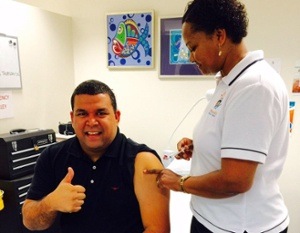
Aboriginal community-controlled health organisations are improving health outcomes for Aboriginal people. We need to continue to invest in, and expand, these services as they have proven time and time again to be the best model of primary health care for Aboriginal people.
In 2006, as a young 19-year-old, I was appointed chief executive officer of the fledgling Aboriginal community-controlled health service in Gladstone, Nhulundu Wooribah Indigenous Health Organisation.
With the support of the board and a small but dedicated staff, we were able to take this very under resourced, local primary health organisation with a few community programs, and turn it into a major force for Aboriginal health in the region. When I left the service it employed more than 30 clinicians and health professionals across a broad range of services and continues to provide great health care to the local community today.
In 2012, I took a break from the Aboriginal health sector and spent two years as Indigenous affairs manager for international company Bechtel.
My passion for the sector was never far away however, and during this time I filled the role of deputy chair of the national health peak body, the National Aboriginal Community Controlled Health Organisation (NACCHO), sat on the board for Queensland Aboriginal and Islander Health Council (QAIHC), and was instrumental in the establishment of the Central Queensland Regional Aboriginal and Islander Health Organisation (CQRAICCHO) and later became a skills-based director.
Mid last year, I was appointed chief executive officer for QAIHC and soon after, the chairperson of the NACCHO.
In both roles my aim is to improve the health of Aboriginal people and ensure Aboriginal people have control and autonomy over their own health.
The Aboriginal community-controlled sector delivers comprehensive primary health care in 302 sites nationally; has over 45 years of cultural capability, integrity, knowledge, and experience for the advancement of Aboriginal and Torres Strait Islander peoples dating back to early 1970s with the establishment of our first Aboriginal medical service in Redfern.
Our services are the largest employer of Aboriginal and Torres Strait Islander people within Australia and deliver 2.5m episodes of care to an estimated 342,000 Aboriginal and Torres Strait Islander people and other Australians annually.
Critically, they have made a major contribution to meeting the closing the gap targets that have reduced child mortality rates by 66% and overall mortality rates of Aboriginal and Torres Strait Islander people by 33% over the last two decades.
Only by improving the heath of Aboriginal people will we be able to tackle other areas of disadvantage – sick kids can’t get to school and sick adults can’t get to work. That’s why I’m so committed to achieving generational change in the health of Aboriginal people.
#IHMayDay15 is a day for Aboriginal and Torres Strait Islander people to share their views and knowledge about some of the wide-ranging issues affecting health, and for non-Indigenous people to participate by RT-ing and listening.
- “Our stories, our way” – each week, a new guest hosts the @IndigenousX Twitter account to discuss topics of interest to them as Aboriginal and/or Torres Strait Islander people. Produced with assistance of Guardian Australia staff.
